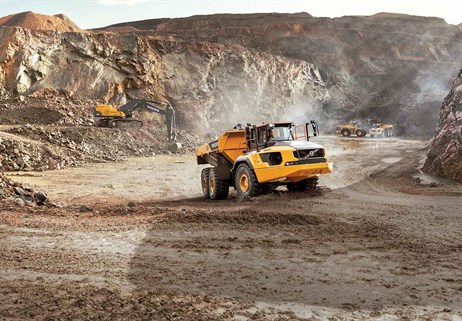![]()
Will increased ADT load capacity provide a suitable solution to increasing aggregate and earthmoving haulage needs? Mike Woof reports
The rule of thumb with off-highway machinery is that for bulk operations, larger equipment can deliver economies of scale, with bigger payloads allowing a better cost/tonne. Heavier machines may be less versatile than more compact units, so a type of equipment that retains its versatility as it is scaled up in size can offer major benefits.
Heavier machines may be less versatile than more compact units, so a type of equipment that retains its versatility as it is scaled up in size can offer major benefits.
For the articulated dumptruck, versatility is one of its key benefits. And the start of 2016 has seen two well established ADT manufacturers unveil haulers capable of carrying 55tonne loads. Both of these machines attracted considerable industry interest and were the focus of much informed comment at the recent
Both of these machines attracted considerable industry interest and were the focus of much informed comment at the recent
Both of these machines attracted considerable industry interest and were the focus of much informed comment at the recent bauma 2016 exhibition in Munich. The B60E from Bell Equipment is still a prototype and its detail specifications will be subject to change until its development is complete, but Volvo CE’s A60H is now in production and available for orders.
The Volvo CE A60 represents a major step in terms of ADT technology, though it is not the largest ADT the firm has ever produced however. That accolade goes to its specially-built A70* of the late 1990s, but the A60 is the largest ADT currently available as a full production machine.
Both the Bell and Volvo CE machines are intended to offer customers an alternative to rigid haulers of similar capacities currently used in extraction operations, as well as the possibility for moving larger quantities of material in earthmoving jobs. The A60 and B60 are different in design however, while Bell claims its machine is targeted more specifically at extraction needs. Volvo CE’s A60 looks like a larger version of the firm’s existing ADTs, with a conventional three-axle layout. However its 495kW diesel, 55tonne payload, 43.75tonne unladen weight and 98.75tonne gross vehicle weight (GVW) mark it out as a high-capacity, high-productivity hauler. Bell’s B60 meanwhile has a conventional ADT front end but with a shorter, squarer dumpbody and single axle with larger diameter twin tyres. This rear end looks akin to the dumpbody design used for a rigid truck and the firm says that this configuration makes it easy to load with an excavator or wheeled loader.
For the moment at least, Volvo CE’s A60H is the only 55tonne capacity ADT available on the market
Will increased ADT load capacity provide a suitable solution to increasing aggregate and earthmoving haulage needs? Mike Woof reports
The rule of thumb with off-highway machinery is that for bulk operations, larger equipment can deliver economies of scale, with bigger payloads allowing a better cost/tonne. Heavier machines may be less versatile than more compact units, so a type of equipment that retains its versatility as it is scaled up in size can offer major benefits.
For the articulated dumptruck, versatility is one of its key benefits. And the start of 2016 has seen two well established ADT manufacturers unveil haulers capable of carrying 55tonne loads. Both of these machines attracted considerable industry interest and were the focus of much informed comment at the recent bauma 2016 exhibition in Munich. The B60E from Bell Equipment is still a prototype and its detail specifications will be subject to change until its development is complete, but Volvo CE’s A60H is now in production and available for orders.
The Volvo CE A60 represents a major step in terms of ADT technology, though it is not the largest ADT the firm has ever produced however. That accolade goes to its specially-built A70* of the late 1990s, but the A60 is the largest ADT currently available as a full production machine.
Both the Bell and Volvo CE machines are intended to offer customers an alternative to rigid haulers of similar capacities currently used in extraction operations, as well as the possibility for moving larger quantities of material in earthmoving jobs. The A60 and B60 are different in design however, while Bell claims its machine is targeted more specifically at extraction needs. Volvo CE’s A60 looks like a larger version of the firm’s existing ADTs, with a conventional three-axle layout. However its 495kW diesel, 55tonne payload, 43.75tonne unladen weight and 98.75tonne gross vehicle weight (GVW) mark it out as a high-capacity, high-productivity hauler. Bell’s B60 meanwhile has a conventional ADT front end but with a shorter, squarer dumpbody and single axle with larger diameter twin tyres. This rear end looks akin to the dumpbody design used for a rigid truck and the firm says that this configuration makes it easy to load with an excavator or wheeled loader.
For the moment though only the A60 is available and it will take some time before the B60 is fully developed and ready for production. Until then, the A60 will not have a direct competitor as none of the other major ADT manufacturers have, so far, revealed plans to offer a larger machine in this class. Volvo CE’s introduction of the A60 is highly significant and is arguably the firm’s most ambitious move in the ADT market since it launched the first all-wheel-drive hauler to combine centre articulation and a tipping body in the early 1960s.
There are strong arguments favouring the use of larger ADTs in many earthmoving or extraction operations. The ADT is highly versatile and scores over a rigid hauler in that its all-wheel-drive allows it to operate on steeper ramps and on rougher, softer, wetter ground, while its chassis articulation means it can cope with tighter haul road turns.
Restrictions on quarrying in developed nations such as Japan or in Europe are growing tighter and can limit the area that a facility can cover. However permission may in some instances be available for an operation to go deeper, which would result in steeper ramp hauls and tighter turning requirements and in such an instance, an ADT with a greater payload would offer significant benefits.
Bigger ADTs could also suit operations in developing nations with high rainfall at certain times of the year, allowing earthmoving activities to continue during the rainy season.
Some all-wheel-drive rigid haulers have been available also but these have been specialised niche market machines selling in low volumes only.
A key to the acceptance of a larger ADT is the price benefit it offers over a rigid truck of comparable payload. Rigid chassis trucks typically cost more than ADTs but offer longer service life overall. Those at Volvo CE involved in developing the A60 have clearly calculated the variables, identifying the market potential for an ADT offering the 55tonne capacity of a rigid truck. But that ADT has a lower purchase price and, with a shorter working life of around 15,000hours (assuming maintenance procedures are adhered to) before needing a rebuild. Typical customers would include contractors which generally work to shorter project timeframes, as well as shorter fleet financing and replacement timescales than quarry operators.
Meanwhile now that it also owns the Terex Trucks range, Volvo CE can offer its customers the choice of either a 55tonne class rigid hauler or the new A60.
The unveiling of the Bell B60 prototype and the Volvo A60H production model are significant developments in the trend for increasing ADT capacities seen in recent years. But to understand why these trucks are so significant now, it is important to see what was achieved in the past.
For a long time ADT payloads were effectively restricted to around 36tonnes due largely to the availability of suitable tyres. Meanwhile the power to weight ratio has been another key issue for ADTs. Earlier generation diesels did not offer such a good power density as required for ADTs with payloads greater than 36tonnes or so. Squeezing bigger engines between the frame rails was a possibility, but these bigger blocks took up more space and required a significantly heavier front end chassis section, increasing the GVW and chipping away at the power to weight ratio. Performance was restricted as a result, with 36tonnes seen as the biggest payload able to retain a good power to weight ratio. These older generation ADTs with payloads in the 36tonne class would typically offer power to weight ratios of around 4.6kW/tonne of GVW.
There have been attempts to build trucks with payloads larger than 36tonnes in the past. These included DJB’s 50tonne capacity D550 built in the UK and the broadly similar MoAZ 7503 made in Belarus, as well as the 45tonne capacity Wagner Fullback FB-650, which was manufactured in the US. But neither the DJB 550 nor the Fullback FB-650 proved successful, with both suffering from driveline reliability problems and the latter also being underpowered. Information on the operating record of the MoAZ 7503 is not available and the model was largely used in the CIS. Wagner (which had pioneered the all-wheel-drive articulated hauler in the late 1950s, although this did not have a tipping body) did consider building a bigger ADT than the Fullback FB-650. The concept was for a payload of 60tonnes, but the non-availability of a suitable engine or tyres put paid to the project and it was shelved. When Wagner was bought by Atlas Copco, the new owner opted to focus on the underground machines and the Fullback FB-650 was dropped.
Volvo CE’s biggest ever ADT, the A70, was built in limited numbers only and to a special order from a Norwegian firm SNSK, for use at its extraction site on the Spitsbergen archipelago. This offered a 65tonne capacity in its extended, three-axle dumpbody, although using the front end of the then current 36tonne capacity A40, it was underpowered by normal standards. Because the laden portion of the haul cycle was on a downhill slope and the uphill return unladen, the power to weight ratio was not an issue and the machines were used successfully in that specific application.
But the first ADT to beat the 36tonne capacity limit, offer a good power to weight ratio and which was a success internationally, was the Bell B50. This offered a 45.4tonne capacity and followed on from the firm’s earlier B45 prototype. The machine had some key innovations. Bell decided that available axles were unsuitable so the firm devised its own for the B50. The axles had a novel design too, being used as heat sinks to allow cooling for the hydraulic fluid circulating through the brake system.
There was some comment at the time of its launch as to whether the ADT tyres then available would cope with the increased load and still offer a reasonable working life. But the Bell B50 attracted sales in both earthmoving and extraction operations and its good performance in the field proved that the concept was a viable one.
Not long after, Norwegian firm Moxy also launched its MT51, which offered a 46tonne payload. However when Moxy was subsequently bought by Doosan, the new owner decided that market demand for the MT51 was still too small and opted instead to focus on updating the 27tonne and 36tonne capacity models in the range. Although Doosan dropped the larger machine from the line-up, the firm has previously commented that it may revive the 46tonner in an updated form should the market prove sufficient.
Since that time other ADTs with payloads greater than 36tonnes have come on the market. John Deere’s 460E offers a 42tonne payload, with power from a John Deere engine and a structural design heavily influenced by Bell, with which it has a partnership. Volvo CE’s A45 offers a 41tonne capacity, while Caterpillar also now offers its 41tonne capacity 745. MoAZ in Belarus (which merged with Belaz in 2006) unveiled its revived 50tonne payload ADT, the 75035, in 2014.
The development of these larger capacity ADTs has benefited from major advances in engine technology, not to mention the development of new tyres for ADTs that offer higher load capacities.
New generation diesels offer far better power densities than before, permitting the necessary power to weight ratio and without requiring a massive front chassis to accommodate a much larger and heavier engine block. Of the top-of-the-range ADTs on the market from Astra, Bell, Caterpillar, Doosan, John Deere, Komatsu, Liebherr, Terex Trucks and Volvo CE, all of these machines offer a power to weight ratio of around 4.7-5.2kW/tonne of GVW.
According to Volvo CE, the new class of larger ADT tyres have been developed from existing sizes used for scrapers, but modified to suit this different application. Key changes are stronger carcasses that can cope with the higher speeds and greater internal heat being generated, as well as revised tread patterns to match the requirements of the ADT duty cycle.
It remains to be seen how other manufacturers will respond to the introduction of Volvo CE’s A60, as well as Bell’s unveiling of its prototype B60. Clearly, they will wait and see whether a market will develop for an ADT with a payload of 45-55tonnes. As mentioned earlier, Doosan could revive its 46tonne payload truck with a newer engine and transmission. Meanwhile Caterpillar and Komatsu both have substantial R&D capabilities as well as the necessary drives and transmission technologies in-house to develop a larger ADT as a customer alternative to their smaller rigid haulers. Caterpillar in particular has an extensive in-house knowledge base of the ADT sector that is second only to Volvo CE, as well as a broad model line-up and a 41tonne capacity truck to use as a stepping stone to a bigger machine.
For the moment Volvo CE leads the field in ADT capacity but it is already clear that the market is interested in ADTs with payloads greater than 36tonnes. Should the A60 prove its worth onsite, other rivals than Bell’s B60 would seem likely and some preliminary designs may already exist.
*Source: Ultra Haulers page 119, author Mike Woof, published by MBI
Note: all power outputs listed are GROSS and not DIN ratings.
Companies in this article
- bauma
- www.bauma.de
- Bell
- www.BellEquipment.com
- Caterpillar
- www.CAT.com
- Doosan
- www.DoosanEquipment.com
- John Deere
- www.JohnDeere.com
- MoAZ
- www.MoAZ.ru
- Moxy
- www.Moxy-WA.com.au
- Terex Trucks
- www.TerexTrucks.com
- Volvo CE
- www.VolvoCE.com
- Wagner
- Now owned by Atlas Copco:
www.atlascopco.com


















